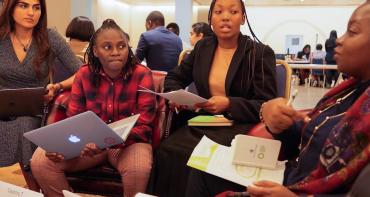Since around 2010, the Commonwealth had been calling on the international community to look towards innovation. It was a period in which most of the memberships’ small and middle-income countries had become incapacitated with debt, whilst also facing the dire risk of more frequent and severe natural disasters.

Since around 2010, the Commonwealth had been calling on the international community to look towards innovation. It was a period in which most of the memberships’ small and middle-income countries had become incapacitated with debt, whilst also facing the dire risk of more frequent and severe natural disasters. During a mission to Washington DC in 2013, the Commonwealth - led by a select few Commonwealth Finance Ministers - lobbied leaders of the IMF, World Bank and the IADB to consider a set of thought-provoking financing instruments, to bring real relief to indebted and natural disaster affected countries. Debt for climate swaps was the main mechanism advanced in this mission, but the Secretariat also advocated for state contingent financing instruments, or what we called at the time – countercyclical financing mechanisms. [1]
While these institutions clearly saw the merit in the Secretariat’s arguments, and in the mechanisms conceptualised, there were several questions raised around their likely feasibility. Nonetheless, the Secretariat continued its campaign with the publications of several informative pieces, still making the case for these types of instruments[2]. These were presented at various workshops and at the Paris Club, where it eventually gained the most traction. Of course, the Secretariat has not been alone in its efforts. The German Development Agency, UNECLAC, UNDP and others have all been pundits of such innovations, and as such I am sure it is heart-warming for all involved to see that the discussion around state contingent financing has now reached as far as the G20. Canada – a prominent Commonwealth country – is leading the charge for innovative financing to tackle the growing incidence of debt in the wake of natural disasters. The government will be presenting on this to Commonwealth Finance Ministers when they meet in Washington in October for discussions under the theme, “Preventing Debt Crises: The Role for Creditors and Debtors”.
With Canada now leading this charge, and with countries like the U.K seemingly supportive, there is ever growing confidence that there is now light at the end of the tunnel.
The Problem – A Growing Frequency in Natural Disasters, Escalating Costs and Debt
Natural disasters have certainly seen an astronomical rise since 1976, moving from less than 10 per year globally, to above 450 in the past three decades.

Though the reasons for this phenomenon has been the source of great debate, a simple juxtaposition of disaster frequency and change in global surface temperature provides evidence of the clear link between the escalation in natural disasters and climate change.

The main challenge for at risk countries, and particularly smaller nations, is the havoc and costs resulting from natural disaster impacts. A higher prevalence of category 5 storms in the past 5 years has meant that damage as a percentage of GDP is now well above anything manageable. Dominica is probably the most glaring example, with damage from tropical storm Erica estimated at USD482.8 million, more than double that country’s GDP. A similar instance occurred in Vanuatu following landfall of hurricane Pam with their damage estimated at USD449.4 million. Imagine if the next hurricane season sees two or three of these monsters affecting numerous islands in the Pacific and Caribbean. And not let’s forget Africa, a new hot spot for cyclones and where landslides and extreme temperatures continue to persist.
It is fair to assume that the probability of the international community being able to mobilise sufficient funds to help these countries is highly unlikely. At August 2019, the global economic environment is already stressed – i.e with Brexit and trade wars between China and the U.S. And the fact is there are just too many competing wants. For instance, the global agendas – the SDGs, Samoa Pathway, Paris Accord, and the UN Framework for Disaster Risk Reduction etc. - all require an insatiable amount of financial resources.
For disaster affected countries, the natural option and only recourse in the face of insufficient assistance is the acquisition of additional debt. Not a very attractive choice given the already high prevalence of indebtedness. In low-income countries, where natural disasters are taking further root, the World Bank says the risk of debt distress has doubled. Additionally, in the Caribbean, debt overhang has remained a stubborn challenge with countries there still holding debt to GDP ratios well above the IMF debt sustainability 60 percent of GDP benchmark. Even for those whose debt levels are more benign, for example in the Pacific region, the frequency of natural disasters and the increase in damages due to their heightened severity, raises the prospect of unaffordable risk premiums, making new debt issuance terribly expensive, and in some cases insurmountable.
In 2010 when the Secretariat raised the alarm bells, creditors were utterly reluctant to even consider state contingent financing. Our mantra – “volatility is the new normal” fell on deaf ears because at that time, climate change proponents were viewed as fear mongers. Fast forwarding to just four years later, some seem to be singing a different tune, for one can surely not dismiss that natural disasters have become more frequent, more severe. Beyond doubts about climate change, creditors mostly struggled with the technicalities, a problem that the international community has recently joined up to solve.
The Consensus - Innovation Beyond Existing Instruments Urgently Needed Despite Technical Difficulties
The fact that natural disasters has increased in probability means that the probability of debt default has increased in tandem. Arguably then, creditors will soon stand more to lose by not incorporating state financing contingencies in their debt contracts. A clear indicator of acceptance of this growing consensus amongst creditors came in the form of debt clauses introduced during the debt restructuring in Grenada, where Paris Club creditors allowed the Government to include in the renegotiated debt terms a pause on debt service during times of severe natural disasters. Another such instance happened only recently, with the Government of Barbados also managing to get their bond holders to agree to a similar debt clause.
This is marked progress but there is still a fair way to climb. Creditors are worried about the impact on cash. And rightly so. Countries too are worried about risk premiums and increased debt burdens, stemming from creditors pricing of natural disaster risks. Allow me to explain.
Explanation – Cash Flow Concerns, Higher Risk Premiums and Debt at Core of Challenge
State contingent financing if applied in its fullest sense will allow countries a stay on debt service if they are impacted by natural disasters of a particular magnitude. During an agreed time period, countries would be able to use foregone debt service to help finance their immediate disaster response and reconstruction, rather than having to acquire additional debt. To facilitate this, creditors would extend the borrower’s maturity by the same length of the debt stay, with the remaining principal outstanding now recalculated on this extended basis. As regards interest payments, these would be recalculated against the new amount of outstanding debt until maturity. However, recall that interest payments are compounded, so extended maturity means a higher level of interest payments.
Firstly, if we accept that natural disasters are growing in frequency and severity, it raises expectations that damages from these events will be increasingly larger and more and more countries could eventually be affected. So just think of a situation in which creditors have built into their debt contracts, state contingent financing instruments for all countries in the Commonwealth Caribbean, for example. Should a massive storm affect all of them, it would mean that debt service cash flows for that creditor could be haulted for say two years. That amounts to millions of dollars in losses for that year, and a liquidity challenge that could be very unmanageable.

Second, debt delayed doesn’t mean debt unpaid. Creditors will not provide a debt stay for free. State contingent financing is not debt relief but rather a provision to allow for the redirection of debt service to finance disaster efforts. Countries stand to pay more than the original outlays for debt due to the increase in maturity and recalculation of interest. Also, and more importantly, due to the pricing of new issues of debt with state contingent financing clauses embedded. Creditors willing to allow a pause in debt service accept higher risks and will want to be compensated. Hence, the price of such debt instruments will be higher. Factoring new pricing and the final cost of debt when state contingent financing instruments are triggered, there remains an increased risk of high debt and debt instability.
Such is reflected in the chart above, which illustrates the impact on debt principal and maturity for state contingent instruments triggered in year 2 and year 8 of a debt contract, relative to a debt contract absent of this mechanism. For a debt stay period of one year, it the increase in principal and interest is more clearly illustrated if we assume no change in maturity.
The Aspiration - Together Countries Can Solve These Problems
These are the core issues which the international community are coming together to solve. They are definitely not simple. However, I am of the school of thought which believes that no feat is impossible, especially when we put our brains together. After all, two or more brains are better than one.
In 2015, it was farfetched to think that these issues would be before the G20, but here we are. It was even more disputable that creditors would give state contingent financing serious thought. I applaud Canada for helping to make this a possible reality, and look forward with eagerness to their thoughts. I look forward, with even greater anticipation, to the perspectives of our Finance Ministers – both creditors and debtors alike.
http://www.stephanygj.net/papers/AnalysisProposalsInstrumentsHelpCountr…; https://www.oecd-ilibrary.org/docserver/5js65z34ffvl-en.pdf?expires=1565947449&id=id&accname=guest&checksum=D9BAEE4DE6C051DF2FDBFAD7E3106F53).
http://thecommonwealth.org/sites/default/files/inline/Extending%20count…;



